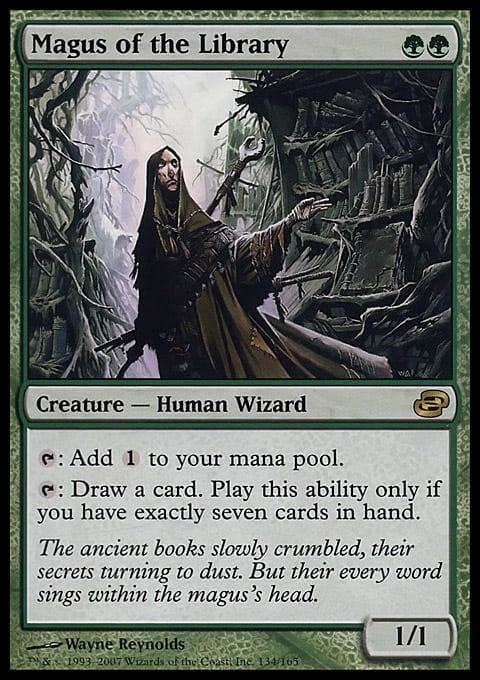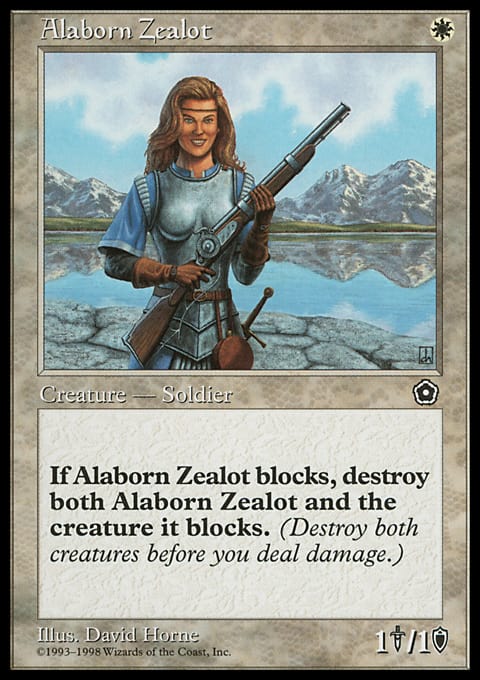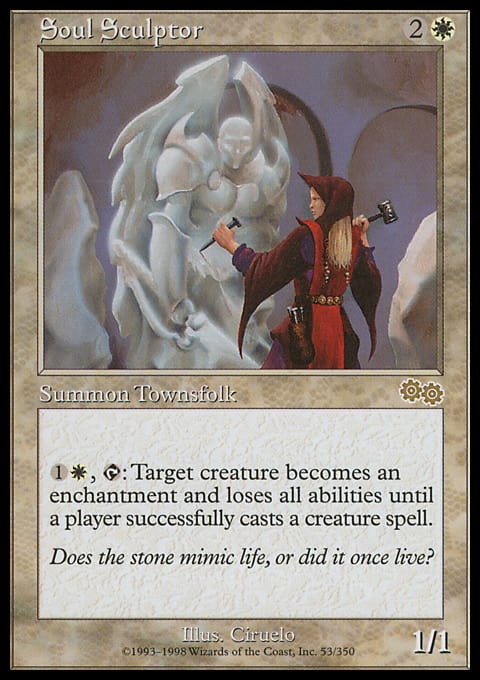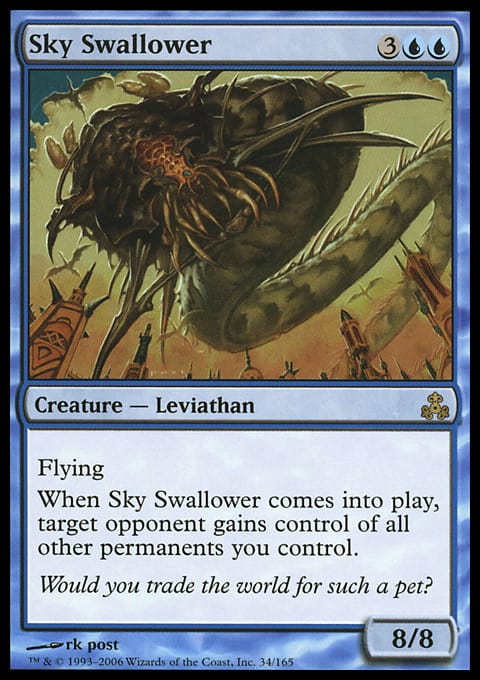 Many years ago, long before Duel Decks, Planechase, or Archenemy, Wizards of the Coast released a product called Vanguard. Used in conjunction with a normal Magic deck, Vanguard cards granted their controllers several static effects, including different starting hand sizes and life totals and one larger effect, usually coinciding with the flavor of the characters' abilities. These would lead to some very interesting games that wouldn't otherwise be possible under normal Magic rules or deck-building constraints. Imagine starting the game out with a Mana Flare or Orcish Oriflamme effect on the board! Unfortunately, as interesting as the format was, Vanguard never caught on, and it was discontinued before ever seeing an official mass release such as with Duel Deck or box sets.
Many years ago, long before Duel Decks, Planechase, or Archenemy, Wizards of the Coast released a product called Vanguard. Used in conjunction with a normal Magic deck, Vanguard cards granted their controllers several static effects, including different starting hand sizes and life totals and one larger effect, usually coinciding with the flavor of the characters' abilities. These would lead to some very interesting games that wouldn't otherwise be possible under normal Magic rules or deck-building constraints. Imagine starting the game out with a Mana Flare or Orcish Oriflamme effect on the board! Unfortunately, as interesting as the format was, Vanguard never caught on, and it was discontinued before ever seeing an official mass release such as with Duel Deck or box sets.
When Magic Online was released, Wizards breathed new life into Vanguard cards and created Vanguard avatars, which were used to display your in-game character profile. You could assign your avatar to a specific decklist and run it in Vanguard tournaments. For each set release, users were able to win a normal or premium avatar usually for winning an eight-man Draft or playing in a release event.
When Dissension was released on Magic Online, the Momir avatar was unleashed on the world.
 At first, people attempted to brew Vanguard decks around him as usual. Most of the good decks at the time involved Life from the Loam, reanimation, and ramp, so you could power out giant 8- to 10-drops consistently without losing steam. Eventually, someone figured out that you don't actually have to cast any spells at all. Through some divine intervention or simple trial and error, two players sat down, each with sixty-card decks consisting of nothing but basic lands, and thus the Momir Basic format was created.
At first, people attempted to brew Vanguard decks around him as usual. Most of the good decks at the time involved Life from the Loam, reanimation, and ramp, so you could power out giant 8- to 10-drops consistently without losing steam. Eventually, someone figured out that you don't actually have to cast any spells at all. Through some divine intervention or simple trial and error, two players sat down, each with sixty-card decks consisting of nothing but basic lands, and thus the Momir Basic format was created.
Unlike any other unofficial Magic Online format, the Momir format was given its own queues and Daily Events. It quickly surpassed formats like Singleton, Prismatic, Rainbow Stairwell, and even Vanguard in popularity, and it became the default casual format. You could hop in the Casual Room at any time and find a pickup game of Momir Basic.
There are very few formats in the history of Magic that have the high amount of variance that Momir Basic has. It's pretty funny given that each player is playing the same deck! At one moment, you could be up five to ten creatures and have your opponent dead on board, when your opponent drops a Kederekt Leviathan. Or maybe you have the misfortune of flipping a Phage or Sky Swallower (not of the Simic variety). Those "Oooooh!" and "Arrrrgh!" moments that make those late-night games of Magic worthwhile are commonplace if you sit down for a few Momir games. It's for this very reason that I want to try to capture some of that and bring the Momir format outside of Magic Online and onto the kitchen table. And so I built The Momir Basic Cube!
Surprisingly, there is quite a lot of Momir Basic strategy on the Internet. I have included a few links to some worthwhile articles and forums posts on the subject at the end of the article. The basic idea is that you grind creatures early, hoping to hit a mana bug or cheap beater and try to make it up to 6 to 10 mana as quickly as possible. From there, you start pumping out the dinosaurs until you hit a big gun or a whammy.
The Momir Cube Vision
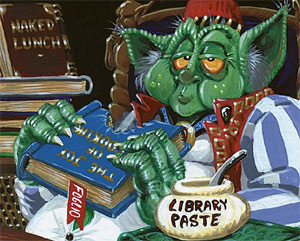 There are over six thousand unique creatures in Magic. If I were to remain true to the Momir format, I would have to lug around several, long boxes full of cards in order to emulate exactly how a game of Momir plays out. Managing the Cube would be quite easy, but keeping track of everything and sleeving something so monstrous doesn't sound like my idea of a good time. Let's not even talk about pimping this Cube out--yikes! I wanted something portable that I can take with me to PTQs, friends' houses, and coffee shops. I knew I wanted something that fit in a long box, so how could I make it feel like the same format?
There are over six thousand unique creatures in Magic. If I were to remain true to the Momir format, I would have to lug around several, long boxes full of cards in order to emulate exactly how a game of Momir plays out. Managing the Cube would be quite easy, but keeping track of everything and sleeving something so monstrous doesn't sound like my idea of a good time. Let's not even talk about pimping this Cube out--yikes! I wanted something portable that I can take with me to PTQs, friends' houses, and coffee shops. I knew I wanted something that fit in a long box, so how could I make it feel like the same format?
Constructing the Momir Vig Cube
There are only eight casting costs with more than 50 creatures. The rest have a small spattering, and some only have one or two total. After mulling over my Momir spreadsheet for months, I decided that the initial draft of the Cube would use this configuration:
1CC = 50 Cards
2CC = 90 Cards
3CC = 100 Cards
4CC = 100 Cards
5CC = 100 Cards
6CC = 100 Cards
7CC = 100 Cards
8CC = 60 Cards
9CC = 30 Cards
10+CC = All Available
This brings the Cube total to about eight hundred cards, plus the two sixty-card, basic-land decks. The entire contents of the Cube fit in one, long box. You're welcome to increase or decrease the size of your Cube as you see fit. If you want a format with more variance, make it bigger. If you want something that is a bit more powerful, keep it small, and be very particular about what you choose to include.
At nearly one-tenth the size of the current Momir card pool, I had to decide how and why to include each card. One method of choosing I came up with was to seek to emulate the Momir card pool by analyzing the casting costs and determining power level. A card could be rated from 1 to 10. I would then map this on a curve and build mine to match this exactly. Here's an example.
1CC
| Bombs = 75 (14%) |
| Vanilla = 375 (70%) |
| Duds = 86 (16%) |
| Total Creatures = 536 |
Momir Cube 1CC
| Bombs = 7 |
| Vanilla = 35 |
| Duds = 8 |
| Total Creatures = 50 |
If you know me, you'll know that I'm pretty crazy about Cubes. Here's the thing: Doing this for every single creature ever printed is madness. Not only is compiling this data tedious and borderline ridiculous, it also still doesn't do a good job mimicking the format at the higher casting costs.
The single biggest reason I dislike this approach is that the overall power level is simply too low. The vast majority of low-to-medium casting cost creatures serve no purpose other than a small chance of generating mana or drawing cards while you wait to play the 6- to 10-drops that will actually do something. Sure, you're getting a good representation of how the format might play out, but you're cubing for crying out loud.
Cubing traditionally combines the best elements of Limited and Constructed into one format. While it takes various aspects of each format and makes it its own, cubing has become a breeding ground for creativity and design. You can choose to make your Cube as balanced and powerful as you deem fit. My regular Cube, for example, is jammed with as much interaction and fun as I can possibly provide, and it occasionally sacrifices power to do so. I decided the Cube would be no different. I stayed very true to the Momir format in early drafts of this list, but the real fun was resolving as many back-to-back powerhouses as possible.
Creating the Environment
One important thing to note on the Momir avatar is the only-once-per-turn clause. Many of the cards I wanted to include have reusable ways to deal with large creature tokens. Cards like Soul Sculptor, Dogged Hunter, and Vodalian Illusionist can very quickly spell game over for your opponents.
Without having access to removal or just being lucky on the flips, I decided the best plan of attack would be to pack the 2- to 4-mana slots with utility creatures such as Man-o'-War and Bone Shredder, which would encourage you to use your smaller Momir activations in the late game. Since you have a much higher chance of hitting mana producers, land destruction, and other various bombs, I have decided to flex the once-per-turn rule. In my list, we have allowed for up to two activations of the avatar per turn. This may sound almost blasphemous, as it even further diverts from the Momir format, but I assure you the payoff is huge.
What kinds of creatures do you want to include in your list? A similarly important question is how frequently you want to hit a 5-star or 1-star (whammy) card. Let's explore.
To Whammy or Not to Whammy
In the first drafts of the list, I included gems like Phage the Untouchable, Sky Swallower, Desolation Angel, and other various cards that spell game over for whomever flips them.
While those cards add an element of fun in not getting a whammy, they're simply too frequent in the smaller card pool and are miserable when flipped. I want the games to be epic, not decided by turning up one bad creature. You can build your list to include these cards, but be warned: They can be frequent in small stacks. Be sure to not include too many of them!
The opposite of a whammy is a 5-star creature. These are the cards you rub your hands together before activating the avatar in hopes of flipping. At the lower casting costs, you almost always want to hit a mana bug or ramp creature. At the medium casting costs, you want to hit land or hand disruption. At the higher casting costs, you want to hit large, evasive Dragons. When you're on the ropes, your best allies are Man-o'-War effects and giant baddies like Hoverguard Sweepers.
Remember that if you're going to have a high concentration of these creatures, you should also have a high concentration of answers to them. I have purposely put extremely useful cards at the 3- and 4-mana slots. The tension of deciding whether a player should play an 8-drop or play two 4-drops adds a whole new dimension to the format.
Now that you have an introduction to the format and Cube vision, here is my current list!
The Momir Cube - 615 Cards
"1CC - 65 Cards"
- Column 1 (33)
- 1 Akrasan Squire
- 1 Alaborn Zealot
- 1 Arbor Elf
- 1 Avacyn's Pilgrim
- 1 Benevolent Bodyguard
- 1 Birds of Paradise
- 1 Boreal Druid
- 1 Brass Man
- 1 Carrion Feeder
- 1 Defiant Elf
- 1 Diregraf Ghoul
- 1 Doomed Traveler
- 1 Dragonmaster Outcast
- 1 Elves of Deep Shadow
- 1 Essence Warden
- 1 Forge Devil
- 1 Fume Spitter
- 1 Fyndhorn Elves
- 1 Ghost-Lit Stalker
- 1 Gideon's Lawkeeper
- 1 Goblin Fireslinger
- 1 Goblin Grappler
- 1 Goldenglow Moth
- 1 Goldmeadow Harrier
- 1 Grim Lavamancer
- 1 Groundskeeper
- 1 Guul Draz Assassin
- 1 Icatian Javelineers
- 1 Joraga Treespeaker
- 1 Kird Ape
- 1 Llanowar Elves
- 1 Loam Lion
- 1 Magus of the Scroll
- Column 2 (32)
- 1 Merfolk of the Pearl Trident
- 1 Mogg Fanatic
- 1 Mother of Runes
- 1 Mountain Goat
- 1 Noble Hierarch
- 1 Orcish Lumberjack
- 1 Perimeter Captain
- 1 Plague Beetle
- 1 Planar Guide
- 1 Rampart Crawler
- 1 Rhys the Redeemed
- 1 Savannah Lions
- 1 Scavenger Folk
- 1 Shanodin Dryads
- 1 Skirk Prospector
- 1 Skyshroud Ranger
- 1 Sleeper Agent
- 1 Spore Frog
- 1 Spurnmage Advocate
- 1 Stormscape Apprentice
- 1 Straw Golem
- 1 Sylvan Safekeeper
- 1 Taunting Elf
- 1 Thornscape Apprentice
- 1 Tinder Wall
- 1 Trickster Mage
- 1 Vebulid
- 1 Veteran Explorer
- 1 Wall of Hope
- 1 Weathered Wayfarer
- 1 Wild Nacatl
- 1 Woodland Druid
"2CC - 75 Cards"
- Column 1 (38)
- 1 Auriok Champion
- 1 Avacynian Priest
- 1 Azure Mage
- 1 Beloved Chaplain
- 1 Blightsoil Druid
- 1 Blinding Mage
- 1 Blister Beetle
- 1 Bloom Tender
- 1 Boros Guildmage
- 1 Budoka Gardener
- 1 Coiling Oracle
- 1 Cuombajj Witches
- 1 Dark Confidant
- 1 Dawntreader Elk
- 1 Devoted Druid
- 1 Dreamscape Artist
- 1 Elvish Visionary
- 1 Ember Hauler
- 1 Fa'adiyah Seer
- 1 Firebrand Ranger
- 1 Fireslinger
- 1 Garruk's Companion
- 1 Harvest Wurm
- 1 Harvester Druid
- 1 Heart Warden
- 1 Hermit Druid
- 1 Kami of the Crescent Moon
- 1 Kiku, Night's Flower
- 1 Lone Missionary
- 1 Lotus Cobra
- 1 Magical Hacker
- 1 Magus of the Library
- 1 Manakin
- 1 Matsu-Tribe Sniper
- 1 Mistmeadow Witch
- 1 Mistmeadow Skulk
- 1 Myr Superion
- 1 Nezumi Bone-Reader
- Column 2 (37)
- 1 Nezumi Shortfang
- 1 Niblis of the Urn
- 1 Oculus
- 1 Orcish Settlers
- 1 Orochi Sustainer
- 1 Perilous Myr
- 1 Phantasmal Image
- 1 Qasali Pridemage
- 1 Quirion Explorer
- 1 Radha, Heir to Keld
- 1 Ravenous Rats
- 1 Renegade Doppelganger
- 1 Sakura-Tribe Elder
- 1 Samite Pilgrim
- 1 Serra Avenger
- 1 Silvergill Adept
- 1 Sindbad
- 1 Skittering Skirge
- 1 Sparksmith
- 1 Spellskite
- 1 Steward of Valeron
- 1 Sygg, River Cutthroat
- 1 Sylvan Ranger
- 1 Tidehollow Strix
- 1 Utopia Tree
- 1 Vine Trellis
- 1 Vinelasher Kudzu
- 1 Viridian Zealot
- 1 Wall of Blossoms
- 1 Wall of Omens
- 1 Wall of Roots
- 1 Wall of Tears
- 1 Watchwolf
- 1 Waterfront Bouncer
- 1 Werebear
- 1 Wind Dancer
- 1 Wyluli Wolf
"3CC - 97 Cards"
- Column 1 (49)
- 1 Aether Adept
- 1 Barrin, Master Wizard
- 1 Battle Rampart
- 1 Blade Splicer
- 1 Blind Zealot
- 1 Bog Witch
- 1 Bone Shredder
- 1 Borderland Ranger
- 1 Callous Oppressor
- 1 Calming Licid
- 1 Cartographer
- 1 Civic Wayfinder
- 1 Cryptoplasm
- 1 Cunning Lethemancer
- 1 Cunning Sparkmage
- 1 Dauntless Escort
- 1 Descendant of Kiyomaro
- 1 Dimir Cutpurse
- 1 Dogged Hunter
- 1 Dominating Licid
- 1 Doran, the Siege Tower
- 1 Edric, Spymaster of Trest
- 1 Eternal Witness
- 1 Farhaven Elf
- 1 Fatespinner
- 1 Fiend Hunter
- 1 Fire Imp
- 1 Fleshbag Marauder
- 1 Flickerwisp
- 1 Fyndhorn Elder
- 1 Garza's Assassin
- 1 Ghitu Slinger
- 1 Giltspire Avenger
- 1 Goblin Sharpshooter
- 1 Hypnotic Specter
- 1 Illusory Demon
- 1 Intrepid Hero
- 1 Jaya Ballard, Task Mage
- 1 King's Assassin
- 1 Kira, Great Glass-Spinner
- 1 Knight of the Reliquary
- 1 Lieutenant Kirtar
- 1 Liliana's Specter
- 1 Mangara of Corondor
- 1 Man-o'-War
- 1 Matca Rioters
- 1 Mine Bearer
- 1 Mirran Crusader
- 1 Mirror Entity
- Column 2 (48)
- 1 Moriok Replica
- 1 Nantuko Elder
- 1 Necrotic Sliver
- 1 Neurok Replica
- 1 Nyxathid
- 1 Ohran Viper
- 1 Oriss, Samite Guardian
- 1 Pallimud
- 1 Phyrexian Rager
- 1 Pilgrim's Eye
- 1 Preacher
- 1 Psychatog
- 1 Rishadan Cutpurse
- 1 Rockslide Elemental
- 1 Rockslide Elemental
- 1 Samite Elder
- 1 Sasaya, Orochi Ascendant
- 1 Scuttlemutt
- 1 Serendib Sorcerer
- 1 Shadowmage Infiltrator
- 1 Silkwing Scout
- 1 Soul Sculptor
- 1 Spawnbroker
- 1 Starke of Rath
- 1 Stitched Drake
- 1 Stronghold Assassin
- 1 Sylvok Replica
- 1 Tempting Licid
- 1 Terravore
- 1 Tilling Treefolk
- 1 Trygon Predator
- 1 Turntimber Basilisk
- 1 Vampire Nighthawk
- 1 Vigean Hydropon
- 1 Vithian Renegades
- 1 Vodalian Illusionist
- 1 Vulshok Sorcerer
- 1 Wake Thrasher
- 1 Wall of Denial
- 1 Wall of Nets
- 1 Wilt-Leaf Cavaliers
- 1 Wistful Selkie
- 1 Wood Elves
- 1 Woolly Thoctar
- 1 Yavimaya Elder
- 1 Yavimaya Granger
- 1 Yavimaya Dryad
- 1 Zo-Zu the Punisher
"4CC - 100 Cards"
- Column 1 (50)
- 1 Abyssal Persecutor
- 1 Abyssal Specter
- 1 Algae Gharial
- 1 Ali from Cairo
- 1 Archivist
- 1 Avalanche Riders
- 1 Aven Augur
- 1 Aven Fogbringer
- 1 Banshee
- 1 Blastoderm
- 1 Blazing Specter
- 1 Blizzard Specter
- 1 Bloodline Keeper
- 1 Boldwyr Heavyweights
- 1 Bounty Hunter
- 1 Braids, Cabal Minion
- 1 Brigid, Hero of Kinsbaile
- 1 Calciderm
- 1 Chameleon Colossus
- 1 Creakwood Liege
- 1 Cytoplast Manipulator
- 1 Desecration Elemental
- 1 Drumhunter
- 1 Eater of Days
- 1 Emeria Angel
- 1 Erhnam Djinn
- 1 Evil Twin
- 1 Faceless Butcher
- 1 False Prophet
- 1 Fatestitcher
- 1 Flametongue Kavu
- 1 Fledgling Dragon
- 1 Galepowder Mage
- 1 Glimmerpoint Stag
- 1 Goblin Clearcutter
- 1 Goblin Goon
- 1 Goblin Settler
- 1 Graveborn Muse
- 1 Grinning Demon
- 1 Guardian of the Guildpact
- 1 Guul Draz Specter
- 1 Hellrider
- 1 Hero of Bladehold
- 1 Hokori, Dust Drinker
- 1 Horobi, Death's Wail
- 1 Indomitable Ancients
- 1 Jungle Barrier
- 1 Kor Cartographer
- 1 Kozilek's Predator
- 1 Krosan Vorine
- Column 2 (51)
- 1 Lightning Angel
- 1 Loxodon Hierarch
- 1 Madrush Cyclops
- 1 Magus of the Disk
- 1 Mana Skimmer
- 1 Marble Titan
- 1 Master of the Wild Hunt
- 1 Master Splicer
- 1 Michiko Konda, Truth Seeker
- 1 Mycoid Shepherd
- 1 Mystic Enforcer
- 1 Nantuko Cultivator
- 1 Nekrataal
- 1 Nevermaker
- 1 Nightscape Master
- 1 Obstinate Baloth
- 1 Odylic Wraith
- 1 Olivia Voldaren
- 1 Phantom Centaur
- 1 Phyrexian Defiler
- 1 Phyrexian Metamorph
- 1 Phyrexian Obliterator
- 1 Rafiq of the Many
- 1 Rishadan Footpad
- 1 Rosheen Meanderer
- 1 Rumbling Slum
- 1 Scavenger Drake
- 1 Seismic Mage
- 1 Skinrender
- 1 Skirsdag Cultist
- 1 Solemn Simulacrum
- 1 Soltari Guerrillas
- 1 Somnophore
- 1 Sower of Temptation
- 1 Stalking Yeti
- 1 Stone-Seeder Hierophant
- 1 Sunhome Enforcer
- 1 Surgespanner
- 1 Thalakos Deceiver
- 1 Thieving Magpie
- 1 Tormentor Exarch
- 1 Tradewind Rider
- 1 Tree of Redemption
- 1 Tsabo's Assassin
- 1 Venser, Shaper Savant
- 1 Viashino Fangtail
- 1 Wall of Reverence
- 1 Wilt-Leaf Liege
- 1 Windborn Muse
- 1 Witch Hunter
- 1 Yukora, the Prisoner
"5CC - 81 Cards"
- Column 1 (41)
- 1 Acidic Slime
- 1 Aku Djinn
- 1 Alexi, Zephyr Mage
- 1 Ancient Hydra
- 1 Anowon, the Ruin Sage
- 1 Archon of Justice
- 1 Arc-Slogger
- 1 Azami, Lady of Scrolls
- 1 Baneslayer Angel
- 1 Battlegrace Angel
- 1 Beguiler of Wills
- 1 Bellowing Tanglewurm
- 1 Bloodgift Demon
- 1 Bloodpyre Elemental
- 1 Caldera Hellion
- 1 Cao Cao, Lord of Wei
- 1 Child of Alara
- 1 Chimney Imp
- 1 Cloudgoat Ranger
- 1 Covert Operative
- 1 Deranged Hermit
- 1 Deus of Calamity
- 1 Dominus of Fealty
- 1 Double Header
- 1 Drana, Kalastria Bloodchief
- 1 Dromar's Attendant
- 1 Elvish Bard
- 1 Ethersworn Adjudicator
- 1 Falkenrath Marauders
- 1 Fiend of the Shadows
- 1 Gustcloak Savior
- 1 Invader Parasite
- 1 Jolrael, Empress of Beasts
- 1 Kagemaro, First to Suffer
- 1 Kazuul, Tyrant of the Cliffs
- 1 Keldon Firebombers
- 1 Kiki-Jiki, Mirror Breaker
- 1 Knight-Captain of Eos
- 1 Kodama of the North Tree
- 1 Kresh the Bloodbraided
- 1 Kumano, Master Yamabushi
- Column 2 (40)
- 1 Lightning Reaver
- 1 Mageta the Lion
- 1 Magmasaur
- 1 Magmaw
- 1 Meloku the Clouded Mirror
- 1 Mitotic Slime
- 1 Molder Slug
- 1 Mulldrifter
- 1 Nemesis of Reason
- 1 Ob Nixilis, the Fallen
- 1 Ogre Shaman
- 1 Overbeing of Myth
- 1 Oversoul of Dusk
- 1 Phyrexian Plaguelord
- 1 Precursor Golem
- 1 Predatory Nightstalker
- 1 Razormane Masticore
- 1 Riftwing Cloudskate
- 1 Rushwood Elemental
- 1 Sadistic Hypnotist
- 1 Seedguide Ash
- 1 Seizan, Perverter of Truth
- 1 Serpent Assassin
- 1 Shriekmaw
- 1 Siege-Gang Commander
- 1 Silklash Spider
- 1 Skullmulcher
- 1 Sol'kanar the Swamp King
- 1 Soulgorger Orgg
- 1 Spiritmonger
- 1 Stag Beetle
- 1 Staunch Defenders
- 1 Stuffy Doll
- 1 Sturmgeist
- 1 Thornling
- 1 Thrashing Wumpus
- 1 Urabrask the Hidden
- 1 Vulturous Zombie
- 1 Wei Assassins
- 1 World Queller
"6CC - 71 Cards"
- Column 1 (36)
- 1 Abyssal Horror
- 1 Admonition Angel
- 1 Aethersnipe
- 1 Arcanis the Omnipotent
- 1 Beast of Burden
- 1 Brontotherium
- 1 Broodmate Dragon
- 1 Bull Cerodon
- 1 Capricious Efreet
- 1 Carnifex Demon
- 1 Child of Gaea
- 1 Cloudthresher
- 1 Conquering Manticore
- 1 Crater Hellion
- 1 Dark Hatchling
- 1 Demonic Hordes
- 1 Dragon Broodmother
- 1 Duplicant
- 1 Elvish Aberration
- 1 Essence of the Wild
- 1 Firemaw Kavu
- 1 Flameblast Dragon
- 1 Frost Titan
- 1 Grave Titan
- 1 Helldozer
- 1 Hoard-Smelter Dragon
- 1 Inferno Titan
- 1 Kokusho, the Evening Star
- 1 Laquatus's Champion
- 1 Magus of the Arena
- 1 Malfegor
- 1 Mana-Charged Dragon
- 1 Meglonoth
- 1 Midnight Banshee
- 1 Mordant Dragon
- 1 Nacatl War-Pride
- Column 2 (35)
- 1 Niv-Mizzet, the Firemind
- 1 Novijen Sages
- 1 Numot, the Devastator
- 1 Oathsworn Giant
- 1 Oros, the Avenger
- 1 Phyrexian Gargantua
- 1 Primeval Titan
- 1 Rampaging Baloths
- 1 Rapacious One
- 1 Realm Razer
- 1 Rhox
- 1 Roil Elemental
- 1 Ryusei, the Falling Star
- 1 Sharding Sphinx
- 1 Silvos, Rogue Elemental
- 1 Skeletal Vampire
- 1 Skyward Eye Prophets
- 1 Soramaro, First to Dream
- 1 Sphinx of Jwar Isle
- 1 Spitebellows
- 1 Steel Hellkite
- 1 Stronghold Overseer
- 1 Sun Titan
- 1 Sunblast Angel
- 1 Tar Fiend
- 1 Tolsimir Wolfblood
- 1 Triskelion
- 1 Vedalken Dismisser
- 1 Vein Drinker
- 1 Victory's Herald
- 1 Visara the Dreadful
- 1 Vorosh, the Hunter
- 1 Wurmcoil Engine
- 1 Xathrid Demon
- 1 Yosei, the Morning Star
"7CC - 52 Cards"
- Column 1 (26)
- 1 Allosaurus Rider
- 1 Ancient Hellkite
- 1 Angel of Despair
- 1 Arbiter of Knollridge
- 1 Archangel of Strife
- 1 Archdemon of Unx
- 1 Avenger of Zendikar
- 1 Bladewing the Risen
- 1 Boldwyr Intimidator
- 1 Butcher of Malakir
- 1 Butcher Orgg
- 1 Charnelhoard Wurm
- 1 Dragon Mage
- 1 Ebon Dragon
- 1 Elesh Norn, Grand Cenobite
- 1 Engulfing Slagwurm
- 1 Gaea's Revenge
- 1 Garza Zol, Plague Queen
- 1 Goblin Dynamo
- 1 Goliath Sphinx
- 1 Hornet Queen
- 1 Ith, High Arcanist
- 1 Kalitas, Bloodchief of Ghet
- 1 Kalonian Behemoth
- 1 Luminous Angel
- 1 Magister Sphinx
- Column 2 (25)
- 1 Magma Giant
- 1 Maul Splicer
- 1 Memnarch
- 1 Myr Battlesphere
- 1 Novablast Wurm
- 1 Palinchron
- 1 Pelakka Wurm
- 1 Phyrexian Ingester
- 1 Platinum Angel
- 1 Rimescale Dragon
- 1 Rockshard Elemental
- 1 Rune-Scarred Demon
- 1 Shauku, Endbringer
- 1 Sheoldred, Whispering One
- 1 Shivan Hellkite
- 1 Simic Sky Swallower
- 1 Spearbreaker Behemoth
- 1 Sphinx of Uthuun
- 1 Szadek, Lord of Secrets
- 1 Thorn Elemental
- 1 Tolarian Serpent
- 1 Triskelavus
- 1 Vengeful Archon
- 1 Vish Kal, Blood Arbiter
- 1 Wormfang Manta
"8CC - 43 Cards"
- Column 1 (22)
- 1 Akroma, Angel of Fury
- 1 Akroma, Angel of Wrath
- 1 Avatar of Hope
- 1 Avatar of Slaughter
- 1 Avatar of Woe
- 1 Benthic Behemoth
- 1 Bloodfire Colossus
- 1 Bogardan Hellkite
- 1 Bosh, Iron Golem
- 1 Celestial Force
- 1 Deathcoil Wurm
- 1 Devouring Strossus
- 1 Filigree Angel
- 1 Gigantomancer
- 1 Godsire
- 1 Hellkite Overlord
- 1 Hoverguard Sweepers
- 1 Infernal Denizen
- 1 Kederekt Leviathan
- 1 Liege of the Tangle
- 1 Living Hive
- 1 Living Inferno
- Column 2 (21)
- 1 Magmatic Force
- 1 Nicol Bolas
- 1 Patron of the Orochi
- 1 Petradon
- 1 Platinum Emperion
- 1 Razia, Boros Archangel
- 1 Sanguine Praetor
- 1 Scornful Egotist
- 1 Scourge of Kher Ridges
- 1 Silver Seraph
- 1 Sisters of Stone Death
- 1 Sphinx of the Steel Wind
- 1 Stormtide Leviathan
- 1 Sundering Titan
- 1 Symbiotic Wurm
- 1 Terastodon
- 1 Tidal Kraken
- 1 Trench Gorger
- 1 Ulamog's Crusher
- 1 Vampiric Dragon
- 1 Verdant Force
"9CC to 15CC - 31 Cards"
- 9cc (14)
- 1 Artisan of Kozilek
- 1 Blazing Archon
- 1 Bringer of the Blue Dawn
- 1 Bringer of the Green Dawn
- 1 Bringer of the Red Dawn
- 1 Crimson Hellkite
- 1 Demon of Death's Gate
- 1 Furnace Dragon
- 1 Grozoth
- 1 Inkwell Leviathan
- 1 Kuro, Pitlord
- 1 Leviathan
- 1 Spirit of the Night
- 1 Teeka's Dragon
- 10cc (8)
- 1 Dragon Tyrant
- 1 Infernal Spawn of Evil
- 1 Jin-Gitaxias, Core Augur
- 1 Kozilek, Butcher of Truth
- 1 Krosan Cloudscraper
- 1 Progenitus
- 1 Spawnsire of Ulamog
- 1 Stratadon
- 11cc (5)
- 1 Darksteel Colossus
- 1 Mycosynth Golem
- 1 Pathrazer of Ulamog
- 1 Polar Kraken
- 1 Ulamog, the Infinite Gyre
- 12cc (2)
- 1 Blightsteel Colossus
- 1 It That Betrays
- 15cc (2)
- 1 Autochthon Wurm
- 1 Emrakul, the Aeons Torn
Setting up for a Game
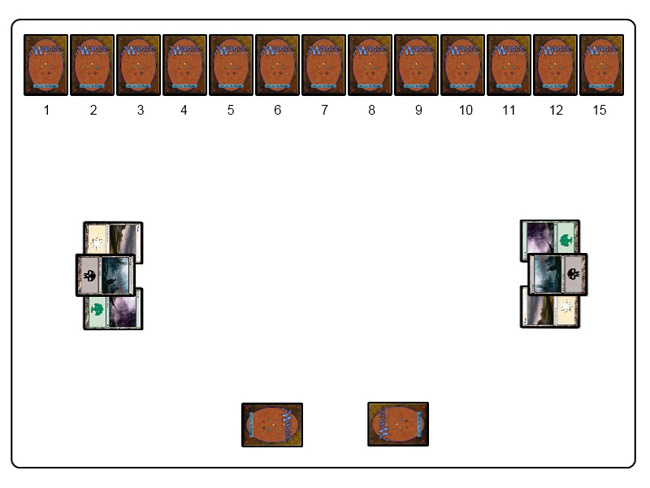
The intended format for this Cube is to create stacks for each casting cost and play games out much like the online version of Momir. Each player has a sixty-card deck with the same number of basic lands. As each player activates the Momir avatar, he takes a card from the respective casting-cost pile. When a card leaves the battlefield, you can either put it on the bottom of that casting cost or simply create an exiled zone and sort it out after several matches have been played.
My good buddy Reuben Bresler was nice enough to volunteer some time to play against me on camera. To watch our match, click here! It should help give you a better understanding of how the format plays out!
I hope you've enjoyed this article and have some interest in creating your own Momir Cube. If you have any comments, questions, or suggestions on the format, feel free to leave them in the comments below or contact me via e-mail or Twitter!
Matt "Kranny" Kranstuber
m.kranstuber at gmail dot com
Follow me on Twitter at @kstube
Momir Basic Resources
Next Level Momir Basic - Steve Gargolinski
Momir Basic for Fun and Profit - Mark Young
Momir Basic Primer - beakerdan
This is my cube philosophy:














